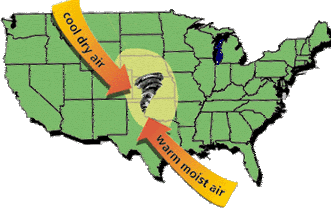
A tornado forms in an intense weather system called a supercell. Supercell storms occur when a warm, moist updraft (such as air from the Gulf of Mexico) punches through an overlying, stable layer and continues upward into a zone of cool, dry air (such as from the Arctic). These conditions are most prevalent in what is known as Tornado Alley, in the central portion of the United States (where about 75% of all tornadoes in the world occur).

The bottom rotating portion of the supercell is called the mesocyclone. Such a storm system is a fertile breeding ground for tornadoes.
The definition of a tornado means that the vortex of rapidly rotating air must be in contact with the ground. This means that to be a tornado, the swirling winds must be at the surface, capable of doing damage.
Much of what was have learned about tornadoes comes as a result of the work done by storm chasers. They drive thousands of miles year, going where tornadoes are likely to occur. They record the tornadoes on film and, when possible, measure them with scientific instruments placed near the storm or directly in its path.
The most destructive tornado in history occurred on March 18, 1925. It was known as the Tri-State Tornado. It ripped through parts of Southeast Missouri, Southern Illinois, and Southwest Indiana. It still holds the record for longest continual track on the ground (219 miles), duration (3.5 hours), the third-fastest forward speed (62 mph), and the greatest number of tornado fatalities suffered by a single U.S. city (234 in Murphysboro, Illinois). It left a total of 695 people dead and over 2,000 injured. At times this monster storm reached F-5 status with winds over 300 miles per hour, as it moved forward at the record speed of 73 miles per hour. Nowadays we have satellite imaging and state-of-the-art weather forecasting technology to warn us of approaching storms, and the loss of life from such severe storms is far less.
Tornadoes come in all shapes, sizes, and strengths. The Fujita Tornado Intensity Scale is used to categorize tornadoes according to the damage that they cause. Thus, tornadoes are not given a Fujita scale ranking until after they have hit an area and the resultant damage can be assessed.
(Hypothetical) |
There is evidence supporting the idea of an F6 tornado, although such a powerful tornado has never been proven to exist. It just sounded so cool I had to put it on here!
Tornado Pictures & Video
 Video of F5 tornado in Jarrell, Texas, May 27, 1997
Video of F5 tornado in Jarrell, Texas, May 27, 1997Tornado Links
 NOAA Tornado FAQ
NOAA Tornado FAQ